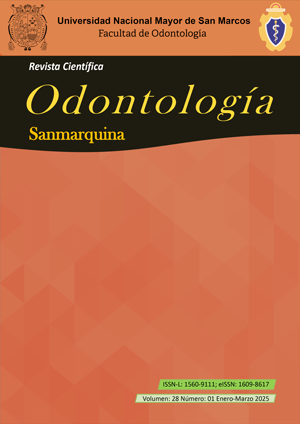Pedicled tongue flap for the treatment of anterior oronasal fistula. Report of 3 cases
DOI:
https://doi.org/10.15381/os.v28i1.27645Keywords:
Tongue flap, palatine fistula, oronasal fistula, cleft palateAbstract
An oronasal fistula (ONF) is an abnormal communication between the oral cavity and the nose that can be caused by traumatic, post-operative, oncological sequelae and congenital malformations. ONF are usually complicated to treat for multiple local anatomical reasons. Among the various closure options is the pedicled lingual flap (PLF), which can be used to close defects larger than 2 cm, but requires certain additional care during the post operative recovery. Objective: To show, through the report of 3 cases and a review of the literature, the benefits and disadvantages of the PLF surgical technique in cases with oronasal defects greater than 2cm. Case report: 3 male patients, between 17-24 years old, were included. As a consequence of a previous unsuccessful procedure, all of them had anterior palatine fistulas greater than 2 cm, two due to palatoplasty and one as a consequence of a gunshot wound. The patients underwent surgery using the PLF technique. Subsequent follow-ups showed a successful and functional closure. Conclusion: The PLF is a relatively simple and predictable surgical technique, due to the good vascular irrigation provided by the pedicle, resulting in a good option in patients with persistent sequelae of ONF, previously operated on or who do not have an affinity for the use of obturators, the technique provides a safe and higher success rate, as long as the patient understands the difficult commitment of postoperative management and longer recovery time that limits mouth opening, ingestion, hygiene, speech and the need for a second surgical procedure.
Downloads
References
Noemí L, Pablo B, Eugenio N, Lissette C. Tratamiento integral de fisura palatina con injerto de lengua. Informe de caso. Rev clínica periodoncia implantol rehabil oral [Internet]. 2017; 10(3): 163–5. DOI: http://dx.doi.org/10.4067/S0719-01072017000300163
Licéaga-Escalera C, Vélez-Cruz M. Colgajo lingual para cierre de fístula oronasal: aportación a la técnica. Rev Esp Cir Oral Maxilofac [Internet]. 2012; 34(1): 31–4. https://scielo.isciii.es/scielo.php?script=sci_arttext&pid=S1130-05582012000100005
De La R, Vladimir JM, Miranda AC. Lingual flap for the closure of a palatal fistula in cleft lip and palate sequels. A case presentation. Revista Mexicana de Cirugía Bucal y Maxilofacial. 2011; 7(3): 109–12. https://www.medigraphic.com/pdfs/cirugiabucal/cb-2011/cb113g.pdf
Park, M. S., Seo, H. J., & Bae, Y. C. (2022). Incidence of fistula after primary cleft palate repair: a 25-year assessment of one surgeon's experience. Archives of plastic surgery, 49(1), 43–49.DOI: https://doi.org/10.5999/aps.2021.01396
Bracka. A. The Blood supply of Dorsal tongue flaps. British Journal of PIastic Surgery. 1981;34: 379-384.
Torres D, Robalino F, Sandoval Portilla F. Colgajo dorsal de lengua de base posterior para cierre de defecto palatino secuela de resección oncológica. Reporte de caso clínico. OdontoInvestigación. 2018; 4(1). DOI: https://doi.org/10.18272/oi.v4i1.1121
Velázquez J, Maraz D, Ospino L. Cierre de fístula palatina con colgajo anterior de lengua. Rev Soc Odontol La Plata [Internet]. 2016;año XXVI, no. 52 https://sedici.unlp.edu.ar/handle/10915/154694
Partida AIG, Lugo RR. Reconstrucción de fístula palatina anterior con colgajo lingual de base anterior. Reporte de un caso. Rev Odontol Mex [Internet]. 2016; 20(1): 50–6. DOI: https://doi.org/10.1016/j.rodmex.2016.02.008
Dávalos AAD, Ayala RM, Dau EA. Colgajo lingual de pedículo anterior, alternativa quirúrgica para corrección de fístula palatina anterior mayor de 2 cm - (Anterior pedicle tongue flap, surgical alternative for correction of anterior palatine fistula greater than 2 cm). Revista Colombiana de Cirugía Plástica y Reconstructiva [Internet]. 2021; 27(2). https://ciplastica.com/ojs/index.php/rccp/article/view/179
Reynaldos Del Pozo J, Ángel González De Santiago M, Pimentel E, María K, Frías L. Reconstrucción de fístula oronasal con colgajo de lengua de base anterior. Reporte de un caso. 2013; 9: 59–65. https://www.medigraphic.com/pdfs/cirugiabucal/cb-2013/cb132c.pdf
Sendota Hincapié JC, López Noriega JC, Ruiz Rodríguez R, Sámano Osuna I. Cierre de fístulas palatinas amplias mediante colgajos de lengua en pacientes con secuelas de paladar hendido. Rev Odontol Mex [Internet]. 2006;10(3):131–7. DOI: https://doi.org/10.22201/fo.1870199xp.2006.10.3.15901
Galvis Aparicio AX. Colgajos locales y pediculados en el manejo de las comunicaciones y fístulas oroantrales. Rev Med [Internet]. 2011; 19(2): 217. DOI: https://doi.org/10.18359/rmed.1282
Ruiz-Rodríguez R, López-Noriega JC. Reoperations in Cleft Lip and Cleft Palate Treatment. Oral and Maxillofacial Surgery Clinics of North America. 2011 Feb; 23(1): 169–76. DOI: https://doi.org/10.1016/j.coms.2010.12.002
Barazarte D, Muñoz R, Golaszewski J, Pulgar B, Moro L, Maldonado A. Use of tongue flap as alternative for the closure of Palatinal fistulas in patients with sequela of palatoplasty. Rev Esp Cir Oral Maxilofac [Internet]. 2020; 42. DOI: https://doi.org/10.20986/recom.2020.1100/2019
Downloads
Published
Issue
Section
License
Copyright (c) 2025 Antonio Gagliardi-Lugo, Veronica Viloria, Carlos Millan-Golindano, Ramses Palma-Suarez

This work is licensed under a Creative Commons Attribution 4.0 International License.
AUTHORS RETAIN THEIR RIGHTS:
a. Authors retain their trade mark rights and patent, and also on any process or procedure described in the article.
b. Authors retain their right to share, copy, distribute, perform and publicly communicate their article (eg, to place their article in an institutional repository or publish it in a book), with an acknowledgment of its initial publication in the Odontología Sanmarquina.
c. Authors retain theirs right to make a subsequent publication of their work, to use the article or any part thereof (eg a compilation of his papers, lecture notes, thesis, or a book), always indicating the source of publication (the originator of the work, journal, volume, number and date).






